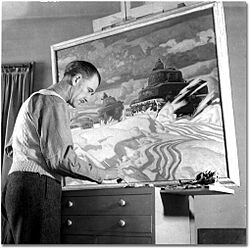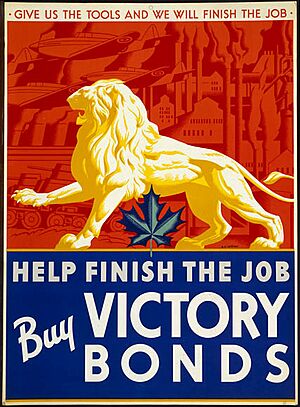A. J. Casson facts for kids
Quick facts for kids
A. J. Casson
OC RCA
|
|
|---|---|

Casson in 1943
|
|
| Born |
Alfred Joseph Casson
May 17, 1898 |
| Died | February 20, 1992 (aged 93) Toronto, Ontario, Canada
|
| Known for | Painting |
| Spouse(s) |
Margaret Alexandria Petry
(m. 1924) |
Alfred Joseph Casson (May 17, 1898 – February 20, 1992) was a well-known Canadian artist. He was the youngest member of the famous Group of Seven. This group of artists was known for painting Canadian landscapes. Casson joined the group in 1926. He was invited by his friend and fellow artist, Franklin Carmichael. Casson is especially known for his paintings of southern Ontario. He often used a special, limited set of colours in his art.
Contents
Life as an Artist
Casson was born in Toronto, Ontario, on May 17, 1898. His father was English, and his mother was Canadian. When he was nine, his family moved to Guelph. Later, they moved to Hamilton when he was fourteen.
Early Art Training
Casson first learned about art at Hamilton Technical School. His teacher even asked him to show his skills to the class. At age 15, he started working as an apprentice. This was at a company that made prints using a method called lithography.
In 1915, his family moved back to Toronto. There, he took private art lessons with Harry Britton. Britton taught him how to use oil paints and watercolours. Casson loved painting with watercolours. While working, he also took evening classes at Central Technical School. His art was first shown to the public in 1917. This was at the Canadian National Exhibition.
Working and Painting
Casson worked for a company called Brigden's. They made commercial art and engravings. In 1919, he moved to Rous and Mann Ltd. There, he worked with Group of Seven member Franklin Carmichael. Carmichael encouraged Casson to sketch and paint on his own.
Later, Carmichael and Casson worked at Sampson-Matthews Ltd. This was the first company in Canada to do silkscreen printing. Casson worked there from 1926 until 1958. After Carmichael left in 1932, Casson became the Art Director. He later became the vice-president in 1946.
Joining the Group of Seven
During the 1920s, Casson kept painting in his free time. He painted alone and with the Group of Seven. He really enjoyed painting with watercolours. In 1925, he helped start the Canadian Society of Painters in Water Colour. He did this with Carmichael and F. H. Brigden.
In 1926, Casson was invited to join the Group of Seven. He took the place of Frank Johnston, who had left the group. In the same year, he also became a member of the Royal Canadian Academy. He later became its president in 1949. Carmichael also introduced Casson to The Arts and Letters Club of Toronto.
Later Career and Style
In 1924, Casson married Margaret Petry. After the Group of Seven ended in 1932, Casson helped start a new group. This was called the Canadian Group of Painters. Many members of the Group of Seven joined this new group too. These included Lawren Harris, Arthur Lismer, A. Y. Jackson, and Franklin Carmichael.
Casson developed his own painting style. He used clear colours and simple designs. He also used a limited set of colours. Artist Lawren Harris had talked to him about simplifying art. This meant removing anything that wasn't essential.
In 1954, Casson was one of 18 Canadian artists chosen for a special project. They were asked by the Canadian Pacific Railway to paint large pictures, called murals. These murals were for the inside of new train cars. Each mural showed a different national or provincial park. Casson's mural was of Algonquin Provincial Park.
Casson "retired" from Sampson-Matthews in 1958, at age 60. This allowed him to paint full-time. He also helped the police find fake artworks. He helped identify forgeries of Tom Thomson and other Canadian artists.
A. J. Casson passed away on February 20, 1992. He was almost 94 years old. He is buried at the McMichael Canadian Art Collection. Six other Group of Seven members are also buried there.
Awards and Recognition
Casson received many honours for his art:
- 1940: Became a full member of the Royal Canadian Academy of Arts. He was elected president in 1940.
- 1942: Won a national competition for designing a poster for a Victory Bond.
- 1948: Received the Province of Ontario Award.
- 1954: Won a Gold medal for his great service to advertising in Canada.
- 1957: Received a Gold medal from the University of Alberta.
- 1967: Awarded the Silver Centennial Medal.
- 1969: Received the RCA Medal.
- 1973: Became a Fellow of the Ontario College of Art.
- 1975: Received an Honorary degree from the University of Toronto.
- He was made an Officer of the Order of Canada.
Valued Artworks
A painting by A. J. Casson was shown on the TV show "Antiques Roadshow" in 2008. The owner said Casson gave the painting to her grandfather, who was his friend. The painting was valued at $25,000 to $35,000.
On June 1, 2010, a large oil painting by Casson sold for a record price. The painting, called Street in Glen Williams, sold for $542,800. This included extra fees. The painting showed a leafy, autumn scene of Glen Williams. Before the sale, it was expected to sell for $200,000–$250,000. This was the highest value ever given to a Casson painting before an auction.
An art critic named Paul Duval said in 1980 that Street in Glen Williams was Casson's most important autumn painting. The bidding for the painting started at $180,000. It quickly went up to $460,000. The buyer was from western Canada. The previous record for a Casson painting was $489,100, set in May 2005.
On November 23, 2016, his painting Gathering Storm sold for even more. It reached $1,534,000 CDN, including fees. This is the highest amount paid for a Casson painting so far.
At an auction on December 1, 2021, Casson's Pic Island, Lake Superior sold for $481,250. This was an oil sketch on a board. It was originally estimated to sell for $40,000 - $60,000.


